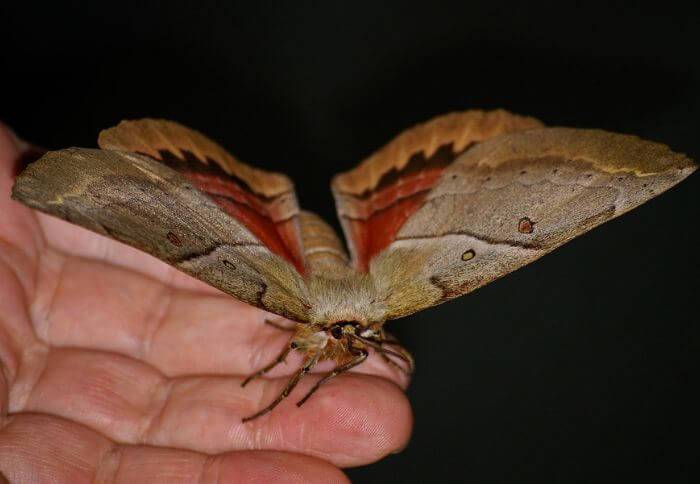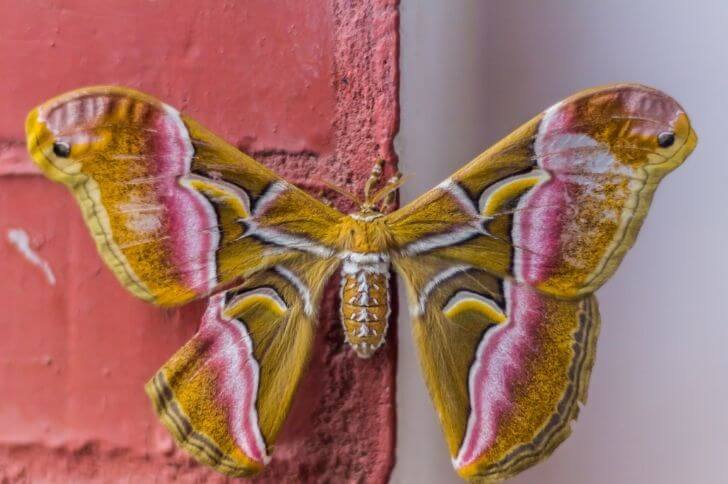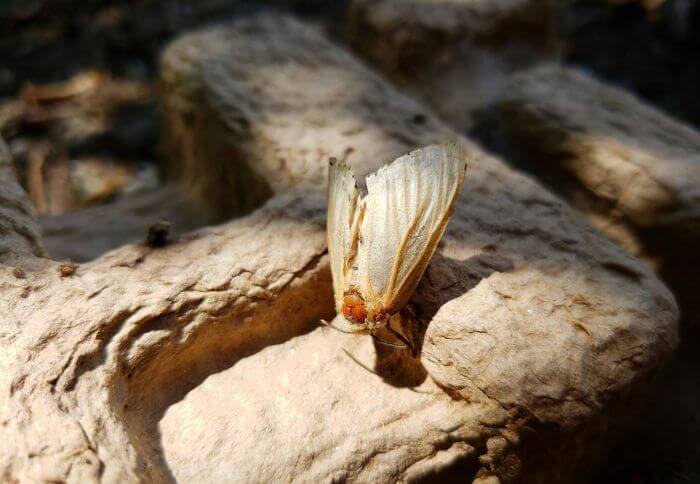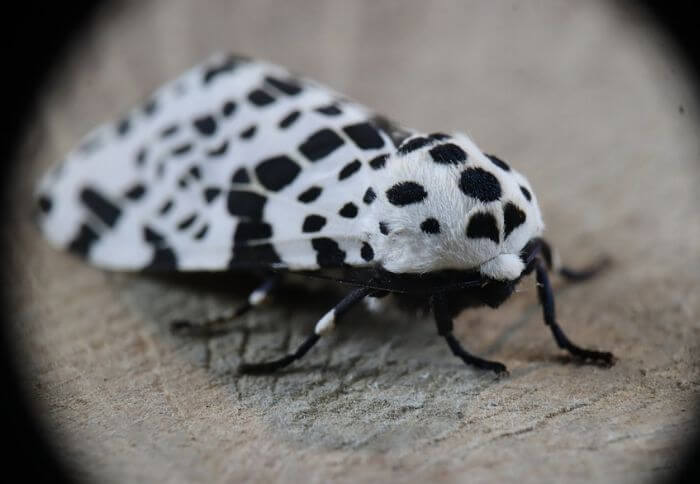10 Large Moths in Colorado (Identification)
Amidst the rugged terrain and alpine beauty of Colorado lies a hidden world teeming with stunning winged creatures – large moths that adorn the night skies in an awe-inspiring display of color and grace.
These majestic insects are not only captivating in appearance but also play crucial roles in their ecosystems, showcasing a remarkable diversity that reflects Colorado’s rich natural heritage.
From their intricate camouflage to their mesmerizing flight patterns under moonlit nights, these gentle giants offer a glimpse into an often overlooked realm of biodiversity within the state’s borders. Let’s delve into this captivating realm as we unveil the wondrous types of large moths that call Colorado home.
List of large moths in Colorado
1. Io moth (females)
Wingspan: 1.96-3.14 inches
The io moth, with its strikingly beautiful wings and bold colors, is a true marvel of nature. Found in the eastern United States, this magnificent moth boasts of vibrant shades of yellow, burnt orange, and brownish color.
However, what makes this brown and yellow moth captivating is its defense mechanism. When threatened or disturbed, the io moth displays its eye-catching eyespots on its hindwings as a warning to potential predators. These eyespots create an illusion that startles and intimidates predators, allowing the io moth to escape unharmed.
In addition to its appearance, this giant moth in Colorado is also a pollinator. With their long proboscises designed for sipping nectar from flowers, these moths inadvertently facilitate plant reproduction while seeking sustenance.
This often-overlooked contribution highlights the intricate interconnectedness of species within their natural habitats. The next time you spot an io moth fluttering among flowers or resting on tree bark, take a moment to appreciate not only its beauty but also the vital role it plays in maintaining biodiversity and ecological balance.
2. Cecropia moth
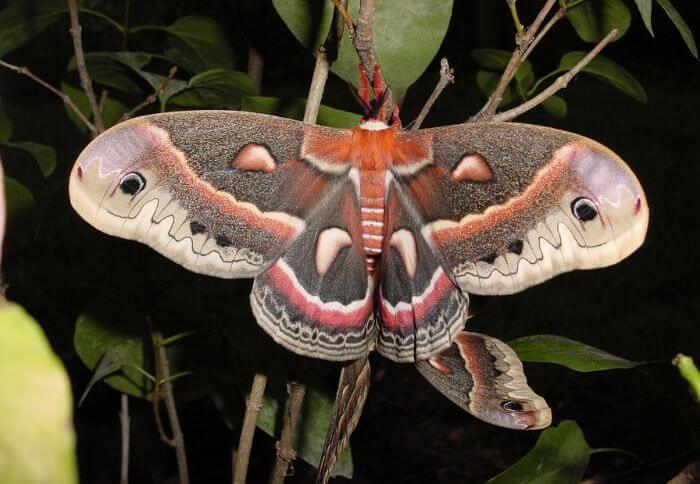
Wingspan: 5-7 inches
The Cecropia moth is a stunning creature that captivates with its large size and intricate patterns.
As the largest native moth species in North America, it boasts a wingspan of up to six inches, making it an awe-inspiring sight to behold. With its vibrant red and brown hues and delicate markings, the Cecropia moth is a true testament to the beauty of nature.
What makes this moth even more fascinating is its life cycle. The Cecropia egg hatches into a green caterpillar that feeds on willow and cherry trees before forming a cocoon.
This transformation to a magnificent winged adult is amazing. Despite their impressive appearance, these majestic moths have a relatively short lifespan; however, they play an important role in pollination and are vital members of their ecosystems.
In addition to their aesthetic appeal and ecological significance, Cecropia moths have also been subject to scientific study due to their unique biological characteristics.
Researchers continue to explore the genetics and behavior of these enchanting creatures in order to gain further insight into their evolutionary development and potential conservation efforts.
It’s clear that the Cecropia moth holds much intrigue beyond just its striking outward appearance – there’s a whole world waiting to be discovered within this magnificent insect.
3. Polyphemus moth
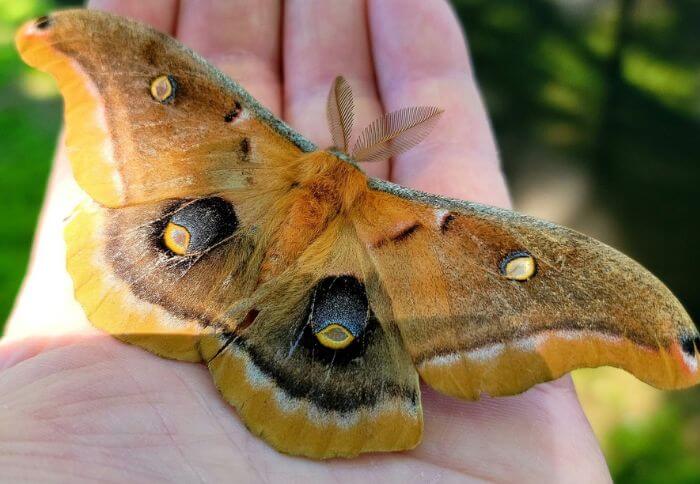
Wingspan: 4-6 inches
The Polyphemus moth, with its stunningly large wingspan of 4-6 inches, is a sight to behold in the Colorado night skies. Its rich brown color and distinct eyespots give it an otherworldly appearance.
What sets the Polyphemus moth apart from other species is its unique ability to blend in seamlessly with its surroundings, thanks to its intricate patterns and colors that mimic bark and leaves. This remarkable camouflage not only helps it evade predators but also adds an element of mystery to its presence in the wild.
One of the most fascinating aspects of the Polyphemus moth is its short but impactful lifespan. After emerging from their cocoons, adult moths live for only about one week, just enough time to mate and lay eggs before completing their life cycle.
4. Big Poplar Sphinx Moth
Wingspan: 4.5-5.9 inches
The big poplar sphinx moth is a striking insect native to the forests of Colorado. With a wingspan of up to 5 inches, this beautiful creature is an impressive sight to behold.
Its wings are adorned with intricate patterns and colors, ranging from shades of brown and cream to vibrant pops of pink and yellow. One cannot help but be drawn to its mesmerizing appearance and graceful flight as it hovers around flowers in search of nectar.
What makes the big poplar sphinx moth even more fascinating is its role in pollination. As it flits from flower to flower, the moth helps transfer pollen, contributing to the health and diversity of the ecosystem.
This interaction between the moth and its surroundings showcases the interconnectedness of nature, reminding us of the delicate balance that exists within our environment.
Observing these magnificent creatures in their natural habitat provides a profound appreciation for the intricate beauty and importance of all living organisms in our world.
As night falls, the big poplar sphinx moth emerges from its daytime hiding spot, adding an air of mystery to its allure. Its nocturnal habits allow for unique opportunities to witness this enchanting insect under a blanket of stars or moonlight.
This aspect emphasizes the unexpected marvels that await those willing to explore nature’s wonders during different times of day. The nighttime dance of these large moths adds an extra layer of magic to Colorado’s wilderness, inviting us into a
5. Imperial Moth
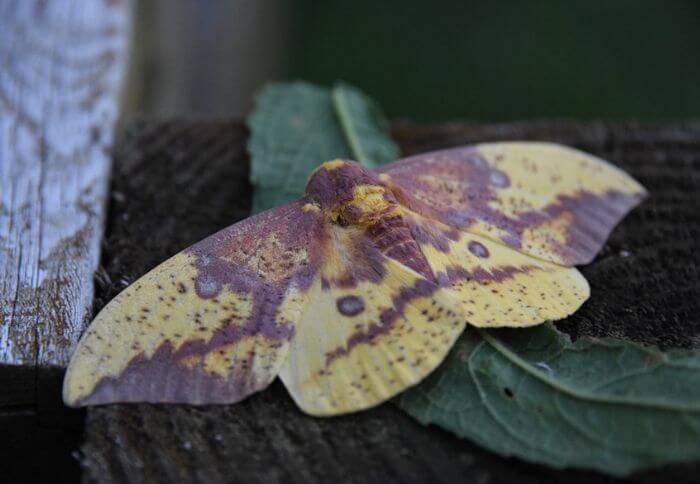
Wingspan: 3.1-6.8 inches
The imperial moth, Eacles imperialis, is a true marvel of nature with its striking colors and impressive size. This majestic moth is native to parts of New Mexico and eastern United States, where it graces the night sky during the summer months.
What sets the imperial moth apart is its vibrant wings adorned with purples, yellows, and pinks, making it a captivating sight for any observer lucky enough to catch a glimpse.
As adults, imperial moths have only one goal: to reproduce. Their short lifespans are dedicated to finding a mate and laying eggs before their time comes to an end.
However, during their brief existence, they play a crucial role in their ecosystems as pollinators and as a food source for predators such as birds and bats. Despite their relatively fleeting presence in the world, imperial moths leave a lasting impression on those fortunate enough to encounter them in all their regal splendor.
Imperial moths are also known for their ability to blend into their surroundings during the day while resting on trees or other surfaces.
Their intricate patterns and subtle colorations make them masters of disguise, evading potential threats from predators while showcasing their natural beauty when it matters most.
Overall, these enchanting creatures serve as a reminder of the awe-inspiring diversity present in our natural world and the importance of protecting these delicate species for future generations to enjoy.
6. White-lined Sphinx

Wingspan: 2-3.5 inches
The white-lined sphinx, also known as the hummingbird moth, is a captivating and mysterious creature that can be found in the mountains of Colorado. With its striking white stripes and intricate patterns, this large moth is a sight to behold against the backdrop of the rugged landscape.
What makes the white-lined sphinx truly fascinating is its ability to hover and feed on nectar just like a hummingbird, earning it the nickname hummingbird moth. This unique behavior sets it apart from other moths and adds an element of wonder to its already impressive appearance.
One interesting aspect of the white-lined sphinx is its role as a pollinator in Colorado’s high-altitude ecosystems. As it flits around, gathering nectar, it inadvertently transfers pollen. This aids in the cycle of various plant species.
This symbiotic relationship between the moth and the flora highlights the interconnectedness of nature in this region. Additionally, observing large moths in Colorado in their natural habitat serves as a reminder of the delicate balance that exists within our environment.
7. Hawk Moth
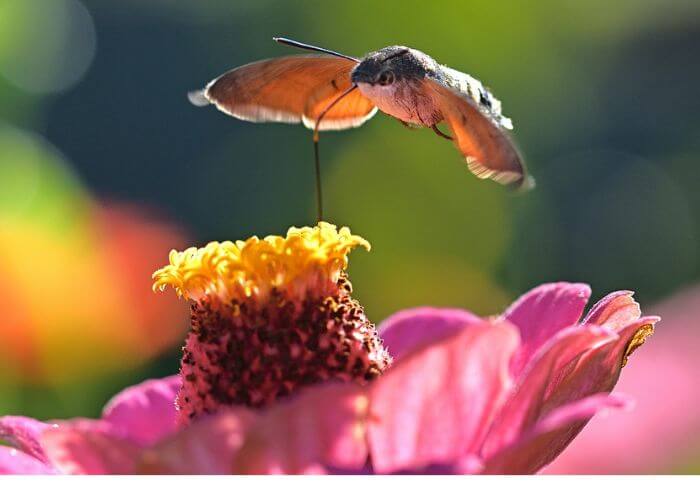
Wingspan: 2-8 inches
The hawk moth, also known as sphinx moth, is a fascinating creature that captivates both scientists and enthusiasts alike. With its large wingspan and swift aerial abilities, this nocturnal insect symbolizes the mysterious beauty of the night.
One of the most striking features of the hawk moth is its long proboscis, which allows it to feed on nectar from deep flowers while hovering in mid-air—a remarkable adaptation that sets it apart from other moths.
One interesting fact about the hawk moth is its role as a pollinator for various plant species. As it flits from flower to flower, this giant moth transfers pollen, helping in the reproductive cycle of some plants.
This unique symbiotic relationship highlights the important ecological role that these creatures play in their habitats. Moreover, some species of hawk moths have co-evolved with specific plants, showcasing an intricate dance between nature and evolution.
In addition to their ecological significance, hawk moths also serve as indicators of environmental health due to their sensitivity to changes in temperature and habitat disruption.
8. Blinded Sphinx Moth
Wingspan: 2-3.7 inches
The blinded sphinx moth, also known as Paonias excaecata, is a mesmerizing creature that is often found in the mountainous regions of Colorado.
Its name stems from its striking appearance and behavior: the moth has large, intricate patterns on its wings that resemble eyes, giving it an almost otherworldly presence. Despite their name, these large Colorado moths are not blind at all.
These sphinxes have remarkable vision that allows them to move at night with ease.
What sets the blinded sphinx moth apart from other species is its unique feeding habits. Unlike many moths that feed on nectar from flowers, these moths are drawn to rotting fruit and tree sap.
This unusual dietary preference plays a crucial role in sustaining their population and contributes to the diverse ecosystem of Colorado’s mountainous terrain.
The symbiotic relationship between the blinded sphinx moth and the plants it helps pollinate highlights the interconnectedness of nature and the vital role each species plays in maintaining ecological balance.
As dusk settles over Colorado’s rugged landscape, witnessing the graceful flight of a blinded sphinx moth becomes an enchanting experience. Their silent fluttering through moonlit meadows and dense forests adds a magical quality to the wilderness that captivates any observer lucky enough to encounter these magnificent creatures.
As they dance among the stars under cover of nightfall, one cannot help but be awed by their mysterious allure and contemplate their significance in shaping Colorado’s natural beauty.
9. Carolina Sphinx
Wingspan: 3.75-4.75 inches
The Carolina Sphinx fascinates nature enthusiasts and researchers alike.
This large Colorado moth flaunts a striking appearance with its vibrant orange and black patterns, making it a sight to behold in the wild. Its unique coloration serves as both camouflage and a warning signal to predators—a clever adaptation in the world of survival.
An intriguing aspect of this giant Colorado moth is its remarkable life cycle. It starts with the egg stage on tomato plants.
As these larvae hatch and grow into hefty caterpillars, they become notorious for their voracious appetite, devouring leaves at an astonishing rate. Despite being considered pests by some gardeners, their role in balancing ecosystems is undeniable—serving as a valuable food source for birds while contributing to pollination through their transformation into magnificent moths.
10. Pandora Pinemoth
Wingspan: 3-5 inches
The elusive Pandora Pinemoth, also known as Coloradia pandora, is a captivating sight to behold in the expansive Colorado wilderness. Recognizable by its striking black and white wingspan that can measure up to four inches across, this enigmatic moth has long fascinated entomologists and nature enthusiasts alike.
What truly sets this large moth apart is its lifecycle, which revolves around the intricately woven relationship with the ponderosa pine. As larvae, these moths feast exclusively on these trees’ needles before transforming into their distinctively patterned adult form.
11. Luna Moth
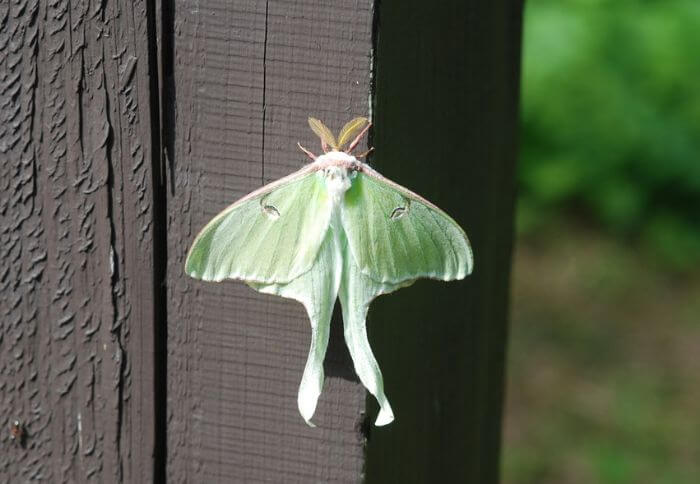
Wingspan: 3-4.5 inches
The eye-catching beauty of the luna moth is a sight to behold in the Colorado wilderness. With its striking lime green color and ethereal wingspan, this majestic creature has garnered attention from both entomologists and nature enthusiasts alike.
Its ability to blend seamlessly into the landscape during the day and emerge as a mesmerizing spectacle at dusk underscores its enigmatic nature.
One fascinating aspect of the luna moth’s life cycle is its relatively short lifespan of only about one week as an adult. During this brief period, they are solely focused on reproduction, with the females emitting pheromones to attract their male counterparts.
This enchanting dance of procreation adds a layer of intrigue to their existence, emphasizing their vital role in maintaining ecological balance within their natural habitat.
Interestingly, luna moths do not have mouths and cannot eat once they reach adulthood. Instead, they rely solely on energy reserves accumulated during their larval stage to sustain them for those few precious days.
This unique adaptation speaks volumes about their evolutionary journey and highlights the delicacy of their existence in the ecosystem.
12. Owlet Moth
Wingspan: 0.3-12 inches
The owlet moth, with its striking and intricate patterns, is a species that never fails to captivate the beholder. These elegant creatures are often adorned with vibrant colors and unique wing shapes that make them stand out among their fellow moths.
Unlike their nocturnal counterparts, the owlet moth is known for its diurnal behavior, making them a rare sight during the day. This distinctive trait adds to their allure, as they flit gracefully among flowers in search of nectar, creating an enchanting spectacle for any observer.
Also, the owlet moth is able to adapt to different environments. Found in a wide range of habitats including meadows, and even urban areas.
Moreover, recent studies have revealed their crucial role in pollination processes, shedding light on the essential contribution of these seemingly delicate insects to the broader ecosystem. With such newfound knowledge about these captivating creatures, it’s impossible not to develop a deeper appreciation for the owlet moth and its significant impact on the natural world.
Final Thoughts:
Colorado is home to a diverse array of large moths, each with its own unique characteristics and behaviors. From the iconic luna moth to the impressive cecropia moth, these insects play an important role in the state’s ecosystem.
Understanding and appreciating the different types of large moths in Colorado can lead to a greater awareness of their ecological significance and promote conservation efforts. By learning about and protecting these large moths in Colorado, we can help in preservation of Colorado’s natural beauty.
Whether through observation or participation in local conservation initiatives, it is up to us to ensure the continued presence of these enchanting insects for future generations to appreciate and enjoy.
source:
Passionate animal photographer with an unwavering love for capturing the essence and beauty of our furry friends.
With over five years of experience in the field, I have developed a unique ability to connect with animals on a deeper level, allowing me to create stunning and captivating images that truly reflect their personality.
Let’s collaborate to capture unforgettable moments that celebrate the unique bond between humans and animals!
